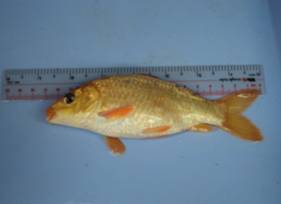 |
 |
|
Photo 1. Common carp |
Photo 2. Tilapia |
| Back to contents |
An experiment was carried out in the research farm of An Giang University from January to April 2011.to compare integrated culture of Tilapia (Oreochomis niloticus) and Common carp (Ciprinus carpio) in an intensive indoor system with earthworms as feed, with an outdoor natural pond system, using biodigester effluent as fertilizer and duckweed as feed supplement. There were four treatments with three replicates in a completely randomized design with mixed stocking of Common carp and Tilapia (50: 50) at low and high densities (3 or 5 fish//m2 in the natural ponds and 60 or 100 fish/m3 in the intensive indoor system. In the outdoor system the fish were raised in natural ponds (4m2), seeded with duckweed and fertilized with biodigester effluent. In the indoor system, the fish were raised in PVC tanks (0.5m3) in an enclosed building and fed with earthworms.
Growth rates at the higher stocking rate were lower for the Common carp in the pond system and tended to be lower for the Tilapia as compared with the low stocking rate. In the indoor system where the fish were fed ad libitum, the growth rates were less affected by stocking density. In the outdoor pond system growth rates were much higher for the Tilapia than for the Çommon carp. In contrast, in the intensive indoor system, there were no differences between the two species. The Tilapia gained from 0.95 to 1.32 g/day at high and low densities in the natural pond system but only 0.26 and 0.33 g/day in the intensive system. In the natural pond system the net fish yields were equivalent to 9 and 10 tonnes/ha/year for the low and high densities, respectively. Environmental pollution, as measured by concentrations of total ammonia-N and nitrite in the water, was some 50% greater in the intensive system. An economic analysis, on the basis of gross returns from the fish less the variable costs (fingerlings and feed), showed positive margins for all species/density combinations in the natural pond system compared with the negative margins for the intensive indoor system.
Key words: Environment, growth rates, pollution, polyculture, rural area, stocking density, variable costs, water quality
Fish production makes an important contribution to global food supply. However, it is a challenge to cope with the considerable and increasing demand of finding new feed sources for fish in production systems which are adapted to the constrains imposed by climate changes and depletion of non-renewable resources. As the human population continues to increase in developing countries so the demands on animal production also increases. When animal production is intensified to meet this demand, so does the pollution of water bodies caused by under-utilized artificial feed and excreta, in the case of aquaculture, and the excreta from live stock. This is already a major problem in the Mekong delta (Tran Thi Phan and Takeshi Watanabe 2002). There are several ways to resolve this problem such as the installation of biodigesters to treat the excreta from live stock and people (Bui Xuan An et al 1997). The effluent from the biodigesters can be used as fertilizer to promote the growth of plankton in natural ponds for fish production (Pich Sophin and Preston 2001) and the growth of water plants such as duckweed (Le Ha Chau 1998), which can be used as supplementary feed for fish (Journey et al 1991; Sen Sorphea et al 2010), ducks (Bui Xuan Men et al 1995; Nguyen Duc Anh et al 1997) and pigs (Bui Hong Van et al 1997; Du Thanh Hang 1998).
The hypotheses underlying the present study were that: (i) biodigester effluent could be used as fertilizer for the natural food chain in outdoor ponds and for the production of duckweed as supplementary feed for the fish; and (ii) that the environmental impact of this system would be reduced and the economic efficiency improved as opposed to the intensive indoor system using earthworms as the feed source.
The experiment was conducted in the experimental farm of An Giang University, Long Xuyen City, Vietnam. The climate is tropical monsoon, with a rainy season between May and October and a dry season from November to April. The mean air temperature is 27°C and annual rainfall 1400-1500 mm. The duration of the study was 105 days, from January to April 2011.
Four treatments were compared in a completely randomized design (CRD), with 3 replications using a 50:50 combination of Common carp (Photo 1) and Tilapia (Photo 2):
NP3: Outdoor system with 3 fish/m2
NP5: Outdoor system with 5 fish/m2
AT60: Artificial indoor system with 60 fish/m3
AT100: Artificial indoor system with 100 fish/m3
In the outdoor system the fish were raised in natural ponds, seeded with duckweed and fertilized with biodigester effluent. In the indoor system, the fish were raised in PVC tanks in an enclosed building and fed with earthworms.
 |
 |
|
Photo 1. Common carp |
Photo 2. Tilapia |
The common carp (Ciprinus carpio) and Tilapia (Oreochomis niloticus) had a weight range of 8.5 to 11.5 g). They were bought from the hatchery in Long Xuyen City.
Management and measurements
Six tanks (each 0.5m3) (Photo 3) were used for the indoor system. The water was changed every two day; 1/3 of the water was changed each time. The water was aerated continuously with one diffuser of 3 cm diameter placed at mid depth in the tank. Fresh earthworms (Photo 5) were fed ad libitum 2 times per day at 7 am and 15 pm.
For the outdoor system, six earthen ponds (1.2m depth x 2 m wide x 2m length = 4m2) (Photo 4) were lined with plastic sheet to avoid filtration of water. The supplementary feed was duckweed grown in the same ponds which were fertilized with biodigester effluent. The amount of feed was recorded and the composition of the feed as dry matter (DM), organic mater (OM), crude protein (CP), crude fat (CF) and fibre was analyzed according to AOAC (1990) methods.
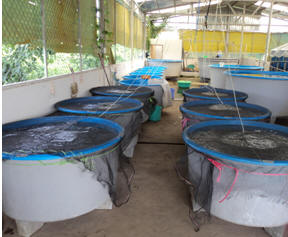 |
 |
| Photo3. Tanks used for indoor system | Photo 4. Ponds used for outdoor system |
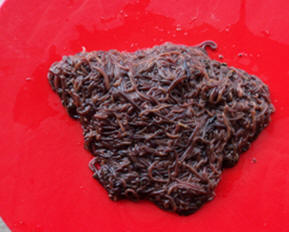 |
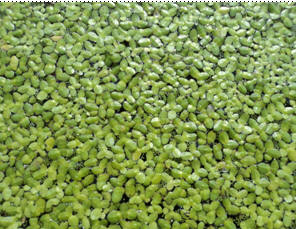 |
| Photo 5. Earthworms | Photo 6. Duckweed |
The effluent was taken from a biodigester charged with pig manure. The quantities added were 3.7 liters/pond, equivalent to 0.532g N/day. When necessary, additional duckweed was added to the ponds so that it accounted for 70% of the area to provide shade and feed for the fish. The amount of effluent put into the ponds was recorded and samples taken for analysis each two weeks.
The temperature, dissolved oxygen (DO), nitrite (NO2-), total ammonia nitrogen (TAN) and pH were measured every week during the experiment. The weight and length of the fish were measured at monthly intervals. The economic efficiency of the two systems was compared.
Specific growth rate (SGR) was calculated as SGR (%/day) = 100 [Ln(wf) – Ln(wi)]/T ….(i)
where:
Wf: Final weight (g)
Wi: Initial weight (g)
T: Number of experimental days
Daily weight gain (DWG) was calculated as: DWG (g/day) = (wf - wi)/T ……………….(ii)
Survival rate (SR%) was calculated as: SR (%) = 100[number of fish harvested/initial number of fish] …….(iii)
Feed samples were analyzed for DM, nitrogen, ether extract and organic matter according to the procedures of AOAC (1990).
The data for feed intake, growth rate and feed conversion were analyzed using the General Linear Model (GLM) of the ANOVA program with the Tukey pair-wise comparison in Minitab software (Minitab release 13.3, 2000). Sources of variation for water quality were: culture system and error; for growth rates the sources of variation were fish species, culture system, interaction of species*culture system and error.
Dissolved oxygen was similar for all treatments in the morning but in the afternoon it was lower in the indoor tanks than in the outdoor ponds (Table 1). The average pH was lower in the indoor system both in the morning and in afternoon. Water temperature was higher in the afternoon than in the morning and higher in the outside ponds than in the indoor tanks. Total ammonia N (TAN) and nitrite-N (NO2-) were much higher in the water in the indoor tanks than in the outdoor ponds. It is assumed the origin of the ammonia in the indoor system was from the decomposition of the un-ingested feed and the fecal material. However, the water quality in all treatments was within the acceptable range for the normal growth of fish (Boyd 1990).
|
Table 1. Mean values for water quality parameters in experimental treatments |
|||||||
|
|
NP3 |
NP5 |
AT100 |
AT60 |
SEM |
P-value |
|
|
DO, mg/litre |
|||||||
|
Morning |
4.12a |
4.25ab |
4.42b |
4.44b |
0.056 |
0.010 |
|
|
Afternoon |
5.34a |
5.05a |
4.49b |
4.47b |
0.074 |
0.0001 |
|
|
pH |
|||||||
|
Morning |
8.04a |
8.01a |
7.33b |
7.23b |
0.055 |
0.0001 |
|
|
Afternoon |
8.25a |
8.32a |
7.58b |
7.57b |
0.042 |
0.0001 |
|
|
Water temperature, °C |
|||||||
|
Morning |
25.3a |
25.3a |
24.1b |
24.0b |
0.069 |
0.0001 |
|
|
Afternoon |
30.3a |
30.2a |
24.7b |
24.8b |
0.099 |
0.0001 |
|
|
TAN, mg/liter |
0.199a |
0.204a |
0.283b |
0.268b |
0.011 |
0.010 |
|
|
NO2-, mg/liter |
0.27a |
0.259a |
0.471b |
0.356a |
0.022 |
0.001 |
|
The protein level in the earthworms was three times higher than in the duckweed, the protein content of which (19.0%) was lower than the levels of 31% reported by San Thy et al. (2004) and 30.5% observed by Sen Sorphea et al (2010). Crude fat in the earthworms was 4 times higher than in duckweed while levels of minerals and fibre were much higher in duckweed than in the earthworms.
|
Table 2. Chemical composition of earthworms and duckweed |
|||||
|
|
% in DM |
||||
|
Moisture |
Ash |
Fiber |
Protein |
Lipid |
|
|
Duckweed |
94.2 |
17.4 |
8.57 |
19.0 |
2.43 |
|
Earthworms |
82.8 |
5.75 |
x |
61.3 |
9.43 |
The effluent contained 900 mg N/liter which was higher than in previous studies of San Thy et al (2004) (835 mg/liter) and Pitch Sophin and Preston (2001) (range from 290 to 470 mg/liter). This probably reflected differences in the feed received by the pigs and the concentration of solids in the influent to the biodigester.
Growth rates at the higher stocking rate were lower for the Common carp in the pond system and tended to be lower for the Tilapia (Table 3; Figure 1) as compared with the low stocking rate. As expected, in the indoor system where the fish were fed ad libitum, the growth rates were less affected by stocking density. In the outdoor pond system growth rates were much higher for the Tilapia than for the Çommon carp (Figure 1). In contrast, in the intensive indoor system, there were no differences between the two species. The growth rates of the Common carp in both systems were much less than was reported by Nguyen Than Hieu and Duong Nhut Long (2010) in a rice-fish model in the Mekong delta (1.44 to 1.55 g/day). For Tilapia at the lower stocking rate in the natural pond system, the growth rate was only slightly less than reported by Lai Qiuming and Yi (No date) for intensive Tilapia culture in China (about 1.5 g/day) and higher than reported in natural pond systems in Cambodia by San Thy et al (2004), Pich Sophin and Preston (2001) and Sen Sorphea et al (2010).
|
Table 3. Mean values for growth performance of Common carp and Tilapia |
||||||||||
|
|
Common carp |
Tilapia |
||||||||
|
|
NP3 |
NP5 |
AT100 |
AT60 |
SEM/P |
NP3 |
NP5 |
AT100 |
AT60 |
SEM/P |
|
Weight, g |
||||||||||
|
Initial |
11.3 |
11.5 |
11.1 |
11.2 |
0.13/0.319 |
8.64 |
8.80 |
8.73 |
8.46 |
0.12/0.3 |
|
Final |
57.0a |
54.3ab |
45.4b |
52.8ab |
2.72/0.008 |
147a |
109a |
36.2b |
42.6b |
12.7/0.001 |
|
Daily gain |
0.44a |
0.27b |
0.33ab |
0.40a |
0.03/0.007 |
1.32a |
0.95a |
0.26b |
0.33b |
0.12/0.001 |
|
SGR |
1.54a |
1.17b |
1.33ab |
1.47a |
0.06/0.008 |
2.67a |
2.39a |
1.35b |
1.52b |
0.11/0.001 |
|
Length, cm |
||||||||||
|
Initial |
9.34 |
9.34 |
9.24 |
9.26 |
0.07/0.64 |
8.23 |
8.43 |
8.17 |
8.07 |
0.12/0.27 |
|
Final |
15.4a |
13.7c |
14.0bc |
14.9ab |
0.23/0.002 |
18.8a |
18.4a |
13.1b |
13.3b |
0.71/0.001 |
|
Daily gain |
0.06a |
0.04c |
0.04bc |
0.05ab |
0.00/0.005 |
0.10a |
0.10a |
0.05b |
0.05b |
0.01/0.001 |
|
a,b,c Means with different
superscripts within fish species within rows are different at P<0.05 |
||||||||||
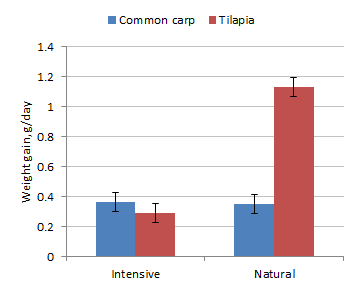 |
| Figure 1. Comparative growth rates of Common carp and Tilapia in the intensive and natural systems |
The data for growth in length (Table 3) showed similar trends as for live weight.
Both species of fish showed an increase in the weight: length ratio as the experiment progressed (Table 4); however, the differences between species were more pronounced in favour of the Tilapia.
|
Table 4. Mean values for weight: length ratio of Common carp and Tilapia (g/cm) |
||||||||||
|
|
Common carp |
Tilapia |
||||||||
|
P3 |
P5 |
T100 |
T60 |
SEM/P |
P3 |
P5 |
T100 |
T60 |
SEM/P |
|
|
Initial |
1.21 |
1.23 |
1.20 |
1.21 |
0.012/0.52 |
1.05 |
1.05 |
1.07 |
1.05 |
0.010/0.33 |
|
Final |
3.71a |
2.87b |
3.25ab |
3.54ab |
0.15/0.018 |
7.76a |
5.90a |
2.77b |
3.18b |
0.55/0.001 |
|
a,b Means with different superscripts within species and within rows are different at P<0.05 |
||||||||||
Survival rates were high and did not differ among treatments (Table 5).
|
Table 5. Survival rate of common carp and tilapia |
||
|
|
Common carp |
Tilapia |
|
NP3 |
100 |
100 |
|
NP5 |
96.7 |
90 |
|
AT100 |
94.7 |
97.3 |
|
AT60 |
100 |
97.8 |
|
SEM |
2.43 |
5.17 |
|
P - Value |
0.378 |
0.574 |
For purposes of comparison, the major variable costs (for fingerlings and feed [earthworms in the intensive system]) were deducted from the gross income from the sale of the fish (Table 6). The margins that resulted from this calculation were expressed on the basis of the total numbers of fish in each density/system combination (##) and also per individual fish (###). Margins were negative in all cases for the intensive indoor system. For the natural system, all species/density combinations showed a positive margin of sale value over variable costs, with the highest value for Tilapia at a density of 3 fish/m2.
|
Table 6. Gross returns and variable costs (fingerlings and feed) of the intensive (indoor) and natural (outdoor) systems |
|||||||||
|
Common carp |
Tilapia |
Common carp |
Tilapia |
||||||
|
|
NP3 |
NP5 |
NP3 |
NP5 |
|
AT60 |
AT100 |
AT60 |
AT100 |
|
Weight, g |
|||||||||
|
Initial |
204 |
345 |
156 |
264 |
506 |
835 |
381 |
655 |
|
|
Final |
1027 |
1141 |
2646 |
2925 |
2376 |
3221 |
1877 |
2638 |
|
|
Costs, VND |
|||||||||
|
Fingerlings |
10194 |
17239 |
4668 |
7923 |
25279 |
41732 |
11424 |
19640 |
|
|
Earthworms# |
160688 |
152952 |
160688 |
152952 |
|||||
|
Total |
10194 |
17239 |
4668 |
7923 |
185967 |
194684 |
172112 |
172592 |
|
|
Sale, VND |
51336 |
57059 |
79383 |
87755 |
118815 |
161055 |
56313 |
79129 |
|
|
Margin## |
41142 |
39820 |
74715 |
79832 |
|
-67153 |
-33628 |
-115800 |
-93463 |
|
Margin### |
2286 |
1327 |
4151 |
2661 |
|
-1492 |
-448 |
-2573 |
-1246 |
|
VND
20,500= USD 1.0 |
|||||||||
The total fish yield in the natural pond system was equivalent to 3 tonnes/ha in 105 days (approximately 10 tonnes/ha/year) with 3 fish/m2 and 4 and 12 tonnes, respectively for the higher density, assuming the same average growth rates over one year. The net fish yields were equivalent to 9 and 10 tonnes/ha/year for the low and high densities, respectively. This net yield is similar to those reported by Journey et al (1991) and San Thy et al (2004)for duckweed-fish systems in natural ponds in Bangladesh and Cambodia, respectively.
In summary, the model of integrated culture of Tilapia and Common carp in natural ponds, using biodigester effluent to promote growth of plankton and duckweed, has a high economic efficiency. This model is appropriate for rural areas in Vietnam, so that low-income people can improve both food and economic security. The model is sustainable because the duckweed is easy to find, growing naturally on existing water surfaces, or to cultivate using the waste water from a biodigester.
In the outdoor pond system growth rates were much higher for Tilapia (1.32 and 0.95 g/day for densities of 3 and 5 fish/m2) than for the Çommon carp (0.44 and 0.27 g/day). In the indoor intensive system, there were no differences between the two species in growth rates which ranged from 0.26 to 0.40 g/day.
In the natural pond system the net fish yields were equivalent to 9 and 10 tonnes/ha/year for the low and high densities, respectively.
Environmental pollution, as measured by concentrations of total ammonia-N and nitrite in the water, was some 50% greater in the intensive system.
The economic analysis, on the basis of gross returns from the fish less the variable costs (fingerlings and feed), showed positive margins for all species/density combinations in the natural pond system compared with the negative margins for the intensive indoor system.
The authors wish to acknowledge the Swedish International Development Authority (Sida) for their financial support of this study, through the MEKARN regional project. Thanks are given to the Aquaculture Department, Agriculture and Natural Resources Faculty, An Giang University, Vietnam, for allowing use of their facilities. In particular, the undergraduate students are greatly appreciated for their excellent assistance during the experiment.
AOAC 1990 (Helrick Editor), Official Methods of analysis. Association of Official Analytical Chemists 15th edition. Arlington. pp 1298 pp.
Boyd C E 1990 Water quality in ponds for aquaculture. Alabama agriculture experiment station, Auburn University. Birmingham Publishing Co. Birmingham, Alabama. First printing 5M, December 1990.
Bui Hong Van, Le Thi Men, Vo Van Son and Preston T R 1997 Duckweed (Lemna spp.) as protein supplement in an ensiled cassava root diet for fattening pigs. Livestock Research for Rural Development http://www.fao.org/ag/aga/agap/frg/LRRD/LRRD9/1/lemen912.htm
Bui Xuan Men, Ogle B and Preston T R 1995 Use of duckweed (Lemna spp) as replacement for soya bean meal in a basal diet of broken rice for fattening ducks. Livestock Research for Rural Development. http://ftp.sunet.se/wmirror/www.cipav.org.co/lrrd/lrrd7/3/2.htm
Du Thanh Hang 1998 Ensiled cassava leaves and duckweed as protein sources for fattening pigs on farms in Central Vietnam. Livestock Research for Rural Development. http://www.lrrd.org/lrrd10/3/hang2.htm
Journey W K, Skillicorn P and Spira W 1991 Duckweed aquaculture: A new aquatic farming system for developing countries, Emena Technical Department, World Bank. http://docs.google.com/viewer?a=v&q=cache:xx9og9jW3PUJ:www-wds.worldbank.org/servlet/WDSContentServer/WDSP/IB/1991/09/01/000009265_3961001235359/Rendered/PDF/multi_page.pdf+Journey,+T.,+P.+Skillicorn+and+B.+Spira+(1991),+Duckweed+aquaculture:+A+new+aquatic+farming+system+for+developing+countries,+Emena+Technical+Department,+World+Bank&hl=en&pid=bl&srcid=ADGEESicaN8J3iol9gHnktVIxDUqvuDF_5kpsKadpqOJtFXU37KDwaE-ke3KnTHsh7P5ik-OKZSRLfaptMcvd_GL-309hW8d8U1p8bTBM9vXcCuG0mGnl_lhidwLxHKBJzBIEiW3pj4H&sig=AHIEtbTt39UAwyEZlUfPrhNsNXlDxYorng
Le Ha Chau 1998 Biodigester effluent versus manure, from pigs or cattle, as fertilizer for duckweed (Lemna spp.). Livestock Research for Rural Development. http://www.lrrd.org/lrrd10/3/chau2.htm
Lai Qiuming and Yi No date Tilapia culture in mainland China. http://aquanic.org/species/tilapia/documents/018.pdf
Minitab 2000 Statistical software Version 13.31.
Nguyen Duc Anh and Preston T R 1997 Evaluation of protein quality in duckweed (Lemna spp.) using a duckling growth assay. Livestock Research for Rural Development. http://www.lrrd.org/lrrd9/2/anh92.htm
Nguyen Thanh Hieu and Duong Nhut Long 2010 Evaluation of growth, survival rate and productivity of common carp (Cyprinus carpio Linaeus, 1758) cultured in integrated rice-fish system. Journal of Science of Can Tho University. Special number. (Vietnamese version)
Pich Sophin and Preston T R 2001 Effect of processing pig manure in a biodigester as fertilizer input for ponds growing fish in polyculture, Livestock Research for Rural Development. http://www.lrrd.org/lrrd13/6/pich136.htm
San Thy, Khieu Borin, Try Vanvuth, Pheng Buntha and T R Preston 2004 Effect of water spinach and duckweed on fish growth performance in poly-culture ponds. Livestock Research for Rural Development. http://www.lrrd.org/lrrd20/1/sant20016.htm
Sen Sorphea, Lundh T, Preston T R and Khieu Borin 2010 Effect of stocking densities and feed supplements on the growth performance of tilapia (Oreochromis spp.) raised in ponds and in the paddy field MSc Thesis, MEKARN-SLU http://www.mekarn.org/msc2008-10/theses/sorp_1.htm
Tran Thi Phan and Takeshi Watanabe 2002 Development of the new technologies and their practice for sustainable farming systems in the Mekong Delta. Proceeding of the 2002 Annual Workshop of JICAS Mekong Delta Project. November 26-28, 2002. College of Agriculture, CanthoUniversity. Vietnam.